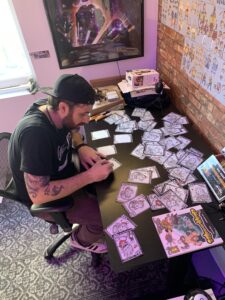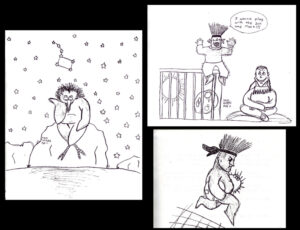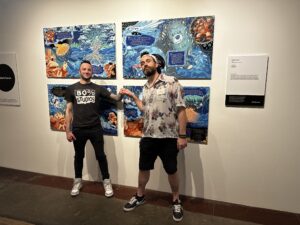
The Raven’s Circle is excited to feature the artwork of CIRI Shareholder Dimi Macheras (Ahtna Athabascan)! Dimi, along with partner Casey Silver, is the founder and owner of 80% Studios, a visual arts publisher and interactive storytelling workshop based in Seattle.
In Alaska, the duo is best known for “Chickaloonies,” a multi-volume, fantasy-adventure graphic novel that follows two Alaska Native characters who begin a quest to find the sun during a time of perpetual darkness. The comic draws on traditional Ahtna stories from Chickaloon.
Dimi is connected to CIRI through his mother, original enrollee the late Patricia Wade (Aug. 17, 1945–July 31, 2014). His grandmother, the late Katherine “Katie” Wickersham Wade (Dec. 15, 1922– March 22, 2009), was clan grandmother of the Chickaloon Tribe. She founded the Ya Ne Dah Ah School, an Ahtna Athabascan (Dené) Tribal school, and was the last known fluent speaker of the Tribe’s language. She was honored as CIRI’s Shareholder of the Year in 2002.
The Raven’s Circle will feature artwork from 80% Studios throughout the year. We recently spoke with Dimi about his family, what inspires him and the “magic” of collaborative storytelling.
On growing up: My mother (Patricia Wade) had Ahtna Athabascan heritage, and my father is Greek. I grew up in Anchorage, Palmer and Moose Creek/Chickaloon. I was really lucky that as a kid I got to travel a lot. We spent many summers in Greece, so I had a wide experience of the world as a young person.
Some of my earliest memories were hearing the traditional Ya Ne Dah Ah (“our ancient teachings”) stories from my grandma, who everyone called Aunt Katie. She was our Tribe’s matriarch. There were stories about Raven and about how we got the sun and the moon. There’s the Besiini (owl) story, which is a cautionary tale, a very spooky story that was told to keep kids from screaming and crying and hollering. In the wild, certain noises will attract predators. This was a way to shut us up, and it worked! Grandma was an amazing storyteller, and all those stories put pictures in my head.

On childhood inspirations: As a child of the 1980s, I was obsessed with Saturday morning cartoons, especially the Teenage Mutant Ninja Turtles. The thing about the Ninja Turtles was the anthropomorphism— animals with human characteristics. Later, I made the connection that the stories my grandma would tell us took place when humans and animals could communicate and had a shared language.
I have a very artistic family, a very musical family. My mother played the guitar and sang. My grandma was an excellent cook and storyteller; she excelled at beading and other Native arts and crafts.
My grandma started the Ya Ne Dah Ah School in Chickaloon in 1992. My cousins and I were the first group of kids who went to the school when it opened. I was 11 years old, and that was right when I first discovered comic books. I was obsessed with comic books, and I was doing artwork all the time. The village paid me to illustrate a few of our Ya Ne Dah Ah stories when I was 11 years old, so that was the first time I collaborated with a storyteller and engaged culturally with our traditional stories.
Dimi graduated from Palmer High School in 1999 and spent two years at art college in Seattle.
On working for the village: After college, I moved back to Alaska and landed a job working for the Chickaloon Native Village education department. The village received a grant for a language-revitalization project, so I could do artwork full time. My cousin, Kari Shaginoff, and I developed all the language curricula. We created posters with the Ahtna alphabet; I got to do drawings of everything, from animals to structures to landscapes. The goal was to create a living artistic dictionary of our language.
This was for about five years, beginning in 2001. The village offices were right next to my grandma’s house. I would go to the office, do artwork, and then hang out with my grandma and chat over coffee and pie while I did more artwork. It was a really beautiful time.
On family support: While I worked for the village, I was given the opportunity to re-illustrate the Ya Ne Dah Ah stories I had originally done when I was 11. I got to illustrate three Ya Ne Dah Ah stories in my comic-book style. It got a lot of attention, and it’s what really set my career on its path.
I was so lucky growing up that Mom and Grandma—my whole family, really—they have always been such a support network for me. I can’t express how important that was for my artistic career, my creativity. My mom was my biggest advocate. Everywhere she went, she would share my artwork. She would go to schools, she would go to gatherings, and she would tell our Ya Ne Dah Ah stories. And she would take the artwork I’d done for those stories and share them in kind of a live PowerPoint-style presentation. So those traditionally oral stories now had a visual component. She created a fanbase for my art.
On the inspiration for “Chickaloonies”: I left Alaska around 2005 or 2006 to move back to Seattle. The one book I didn’t do, that I was planning to do and never got around to doing, was “How We Got the Sun and the Moon.” As I was thinking about how I would illustrate that story, I was asking myself, what would the world look like? I had to draw a story, draw a comic book about how we got the sun and the moon, but there was no light—no daylight, no moonlight. And I had this idea where I was like, well, what about bioluminescence? What about glowing berries, glowing plants, like Christmas lights? My grandma had her Christmas lights up at her house year-round; she loved having this warm, cozy house with all these beautiful glowing nightlights and lanterns and lamps. In my mind, I started conjuring this idea for a world that’s in darkness, yet it’s somehow lit. So that was the seed for what would eventually become “Chickaloonies.”

On meeting Casey and establishing 80% Studios: We (Casey and I) met at a bookstore in Seattle, and it turned out immediately that we were on the exact same wavelength. Casey’s close in age to me; we had very similar upbringings. We were both obsessed with the same comics and with the Ninja Turtles growing up. It was just an incredible moment of destiny to meet Casey because my weaknesses are his strengths and vice versa.
He’s an incredible storyteller. He knows everything there is to know about comic books, everything there is to know about the history of comics, about the hidden art of sequential storytelling. We started working together around 2010 and created our brand, our studio, 80% Comics, which went on to become 80% Studios.
On the meaning behind 80% Studios: It started as kind of a joke and has evolved into something with a deeper meaning. I had an opportunity for a job with Nickelodeon as a storyboard artist. I submitted my portfolio, and when I heard back, I was told, “You’re great, but you’re not quite there. I’d say you’re about 80% there.” It became this ongoing joke with Casey where every failure, every kind of thing we encountered where we didn’t have success, we’d joke that we were “80% there.”
Now, 80% represents to me this journey—of learning, of creativity, of storytelling. I think the sweet spot is almost at the 80% point in the journey, where you’re confident enough to share your work but you’re still learning.
On “Chickaloonies”: During the pandemic, Casey and I were looking for a new project. I was very aware of the doors my mom and grandma had opened for me and the legacy they had left behind. I told Casey that if we were going to create an Ahtna comic book, it needed to be authentic. I wanted to avoid appropriating my own culture; I didn’t want to create a “Native superhero.” I wanted to explore themes and what it means to be an Ahtna person. We had to come correct, because whatever we did was going to have a lot of eyeballs on it. This set the framework for “Chickaloonies.”
My mom is the person who I think started the word “Chickaloonies.” It was a term of endearment for my relatives and the little kids at the school—she called them Chickaloonies. It represents that fun, youthful energy, those little kids going to the same Ya Ne Dah Ah School I went to.
My grandma had always been progressive in her thinking. She encouraged me to illustrate stories how I saw fit. I’m drawing Raven, and he looks kind of like a cartoon character—he’s kicked back, lazy on a couch, an open pizza box next to him. That’s not how our stories were envisioned by our ancestors, but the thing about Ya Ne Dah Ah is that they take place out of space and time in this ethereal realm. So why not? Why couldn’t Raven be wearing sneakers? She allowed me to show things the way I wanted to.
Described as an all-ages Alaskan Tribal adventure, “Chickaloonies” follows the journey of two Alaska Native characters—Sasquatch E. Moji, who only speaks through representations of emojis, and Mister Yelly—on a quest to become the greatest storytellers ever. The first volume was published in 2021.
On the importance of collaboration: Moji and Yelly are a team. Casey and I are a team, and we thrive when we collaborate. We thrive because we can bounce ideas off one another and play to our strengths—his focus is on storytelling, and mine is more on art. When we combine those things, that’s where the magic happens, just like in the book.
Casey and I are part of the artist collective Łuk’ae tse’ taas (Ahtna for “fish head soup”). The collective members were instrumental in our efforts to market “Chickaloonies” in Alaska. My cousin, Ahtna artist Melissa Shaginoff, serves as cultural advisor. We call her the third creator; she’s inspired so many of the moments and themes in the book.
For the “Chickaloonies” book tour, we created a live storytelling experience with sound effects and a slideshow. Casey wore a cardboard costume that Yelly wears in the book. So instead of a book signing where we talk about the book and then everyone stands in line to get their book signed, we told the story live, like how my mom and grandma used to do. We realized the book was almost secondary; the magic was connecting with people through the story, talking and sharing culture.
80% Studios has partnered with the Smithsonian Arctic Studies Center and received a Heritage Project Grant from The CIRI Foundation for its “Creativity and Learning through Indigenous Comic Art” project. The next volume of “Chickaloonies” is due to be released in early 2024. For more information, visit eightypercentstudios.com.



